5 Steps to a 5 AP Chemistry (2015)
STEP 4. Review the Knowledge You Need to Score High
CHAPTER 15. Equilibrium
IN THIS CHAPTER
Summary: We’ve been discussing chemical reactions for several chapters. In the Kinetics chapter you saw how chemical reactions take place and some of the factors that affect the reactions’ speed. In this chapter we will discuss another aspect of chemical reactions: equilibrium.
A few chemical reactions proceed to completion, using up one or more of the reactants and then stopping. However, most reactions behave in a different way. Consider the general reaction:
![]()
Reactants A and B are forming C and D. Then C and D start to react to form A and B:
![]()
These two reactions proceed until the two rates of reaction become equal. That is, the speed of production of C and D in the first reaction is equal to the speed of production of A and B in the second reaction. Since these two reactions are occurring simultaneously in the same container, the amounts of A, B, C, and D become constant. A chemical equilibrium has been reached, in which two exactly opposite reactions are occurring at the same place, at the same time, and with the same rates of reaction. When a system reaches the equilibrium state, the reactions do not stop. A and B are still reacting to form C and D; C and D are still reacting to form A and B. But because the reactions proceed at the same rate, the amounts of each chemical species are constant. This state is sometimes called a dynamic equilibrium state to emphasize the fact that the reactions are still occurring—it is a dynamic, not a static state. An equilibrium state is indicated by a double arrow instead of a single arrow. For the reaction above it would be shown as:
![]()

It is important to remember that at equilibrium the concentrations of the chemical species are constant, not necessarily equal. There may be a lot of C and D and a little A and B, or vice versa. The concentrations are constant, unchanging, but not necessarily equal.
At any point during the preceding reaction, a relationship may be defined called the reaction quotient, Q. It has the following form:


The reaction quotient is a fraction. In the numerator is the product of the chemical species on the right-hand side of the equilibrium arrow, each raised to the power of that species’ coefficient in the balanced chemical equation. It is called the Qc in this case, because molar concentrations are being used. If this was a gas-phase reaction, gas pressures could be used and it would become a Qp.
Remember: products over reactants.

Keywords and Equations

Equilibrium Expressions
The reactant quotient can be written at any point during the reaction, but the most useful point is when the reaction has reached equilibrium. At equilibrium, the reaction quotient becomes the equilibrium constant, Kc (or Kp if gas pressures are being used). Usually this equilibrium constant is expressed simply as a number without units, since it is a ratio of concentrations or pressures. In addition, the concentrations of solids or pure liquids (not in solution) that appear in the equilibrium expression are assumed to be 1, since their concentrations do not change.
Consider the Haber process for the production of ammonia:
![]()
The equilibrium constant expression would be written as:

If the partial pressures of the gases were used, then Kp would be written in the following form:

There is a relationship between Kc and Kp: Kp = Kc(RT)Δn, where R is the ideal gas constant (0.0821 L atm/mol K) and Δn is the change in the number of moles of gas in the reaction.

Remember: Be sure that your value of R is consistent with the units chosen for the partial pressures of the gases.
For the following equilibrium ![]() . Calculate Kc for this equilibrium at 25°C.
. Calculate Kc for this equilibrium at 25°C.
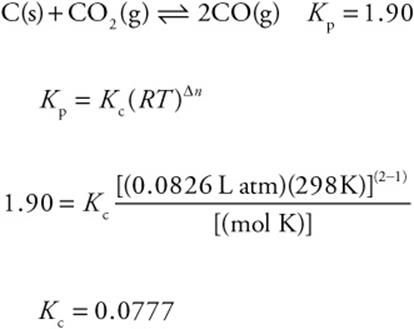
The numerical value of the equilibrium constant can give an indication of the extent of the reaction after equilibrium has been reached. If the value of Kc is large, that means the numerator is much larger than the denominator and the reaction has produced a relatively large amount of products (reaction lies far to the right). If Kc is small, then the numerator is much smaller than the denominator and not much product has been formed (reaction lies far to the left).
Le Châtelier’s Principle
At a given temperature, a reaction will reach equilibrium with the production of a certain amount of product. If the equilibrium constant is small, that means that not much product will be formed. But is there anything that can be done to produce more? Yes, there is— through the application of Le Châtelier’s principle. Le Châtelier, a French scientist, discovered that if a chemical system at equilibrium is stressed (disturbed) it will reestablish equilibrium by shifting the reactions involved. This means that the amounts of the reactants and products will change, but the final ratio will remain the same. The equilibrium may be stressed in a number of ways: changes in concentration, pressure, and temperature. Many times the use of a catalyst is mentioned. However, a catalyst will have no effect on the equilibrium amounts, because it affects both the forward and reverse reactions equally. It will, however, cause the reaction to reach equilibrium faster.
Changes in Concentration
If the equilibrium system is stressed by a change in concentration of one of the reactants or products, the equilibrium will react to remove that stress. If the concentration of a chemical species is decreased, the equilibrium will shift to produce more of it. In doing so, the concentration of chemical species on the other side of the reaction arrows will be decreased. If the concentration of a chemical species is increased, the equilibrium will shift to consume it, increasing the concentration of chemical species on the other side of the reaction arrows.
For example, again consider the Haber process:
![]()
If one increases the concentration of hydrogen gas, then the equilibrium shifts to the right to consume some of the added hydrogen. In doing so, the concentration of ammonia (NH3) will increase and the concentration of nitrogen gas will decrease. On the other hand, if the concentration of nitrogen gas was decreased, the equilibrium would shift to the left to form more, the concentration of ammonia would decrease, and the concentration of hydrogen would increase.
Again, remember that the concentrations may change, but the value of Kc or Kp would remain the same.
Changes in Pressure
Changes in pressure are significant only if gases are involved. The pressure may be changed by changing the volume of the container or by changing the concentration of a gaseous species (although this is really a change in concentration and can be treated as a concentration effect, as above). If the container becomes smaller, the pressure increases because there is an increased number of collisions on the inside walls of the container. This stresses the equilibrium system, and it will shift to reduce the pressure. This can be accomplished by shifting the equilibrium toward the side of the equation that has the lesser number of moles of gas. If the container size is increased, the pressure decreases and the equilibrium will shift to the side containing more moles of gas to increase the pressure. If the number of moles of gas is the same on both sides, changing the pressure will not affect the equilibrium.
Once again, consider the Haber reaction:
![]()

Note that there are 4 mol of gas (1 of nitrogen and 3 of hydrogen) on the left side and 2 mol on the right. If the container is made smaller, the pressure will increase and the equilibrium will shift to the right because 4 mol would be converted to 2 mol. The concentrations of nitrogen and hydrogen gases would decrease, and the concentration of ammonia would increase.
Remember: Pressure effects are only important for gases.
Changes in Temperature
Changing the temperature changes the value of the equilibrium constant. It also changes the amount of heat in the system and can be treated as a concentration effect. To treat it this way, one must know which reaction, forward or reverse, is exothermic (releasing heat).
One last time, let’s consider the Haber reaction:
![]()
The formation of ammonia is exothermic (liberating heat), so the reaction could be written as:
![]()
If the temperature of the reaction mixture were increased, the amount of heat would be increased and the equilibrium would shift to the left to consume the added heat. In doing so, the concentration of nitrogen and hydrogen gases would increase and the concentration of ammonia gas would decrease. If you were in the business of selling ammonia, you would probably want to operate at a reduced temperature, in order to shift the reaction to the right.
Consider the following equilibrium (endothermic as written), and predict what changes, if any, would occur if the following stresses were applied after equilibrium was established.
![]()
a. add CO2
b. remove CO2
c. add CaO
d. increase T
e. decrease V
f. add a catalyst
Answers:
a. Left—the equilibrium shifts to remove some of the excess CO2.
b. Right—the equilibrium shifts to replace some of the CO2.
c. No change—solids do not shift equilibria unless they are totally removed.
d. Right—endothermic reactions shift to the right when heated.
e. Left—a decrease in volume, or an increase in pressure, will shift the equilibrium toward the side with less gas.
f. No change—catalysts do not affect the position of an equilibrium.
Acid–Base Equilibrium
In the Reactions and Periodicity chapter we introduced the concept of acids and bases. Recall that acids are proton (H+) donors and bases are proton acceptors. Also recall that acids and bases may be strong or weak. Strong acidscompletely dissociate in water; weak acids only partially dissociate. For example, consider two acids HCl (strong) and CH3COOH (weak). If each is added to water to form aqueous solutions the following reactions take place:

The first reaction essentially goes to completion—there is no HCl left in solution. The second reaction is an equilibrium reaction—there are appreciable amounts of both reactants and products left in solution.
There are generally only two strong bases to consider: the hydroxide and the oxide ion (OH– and O2–, respectively). All other common bases are weak. Weak bases, like weak acids, also establish an equilibrium system, as in aqueous solutions of ammonia:
![]()
In the Brønsted–Lowry acid–base theory, there is competition for an H+. Consider the acid–base reaction between acetic acid, a weak acid, and ammonia, a weak base:
![]()
Acetic acid donates a proton to ammonia in the forward (left-to-right) reaction of the equilibrium to form the acetate and ammonium ions. But in the reverse (right-to-left) reaction, the ammonium ion donates a proton to the acetate ion to form ammonia and acetic acid. The ammonium ion is acting as an acid, and the acetate ion as a base. Under the Brønsted–Lowry system, acetic acid (CH3COOH) and the acetate ion (CH3COO–) are called a conjugate acid–base pair. Conjugate acid–base pairs differ by only a single H+. Ammonia (NH3) and the ammonium ion ![]() are also a conjugate acid–base pair. In this reaction there is a competition for the H+ between acetic acid and the ammonium ion. To predict on which side the equilibrium will lie, this general rule applies: The equilibrium will favor the side in which the weaker acid and base are present. Figure 15.1 shows the relative strengths of the conjugate acid–base pairs.
are also a conjugate acid–base pair. In this reaction there is a competition for the H+ between acetic acid and the ammonium ion. To predict on which side the equilibrium will lie, this general rule applies: The equilibrium will favor the side in which the weaker acid and base are present. Figure 15.1 shows the relative strengths of the conjugate acid–base pairs.

Figure 15.1 Conjugate acid–base pair strengths.
In Figure 15.1 you can see that acetic acid is a stronger acid than the ammonium ion and ammonia is a stronger base than the acetate ion. Therefore, the equilibrium will lie to the right.
The reasoning above allows us to find good qualitative answers, but in order to be able to do quantitative problems (how much is present, etc.), the extent of the dissociation of the weak acids and bases must be known. That is where a modification of the equilibrium constant is useful.
Ka—the Acid Dissociation Constant
Strong acids completely dissociate (ionize) in water. Weak acids partially dissociate and establish an equilibrium system. But as shown in Figure 15.1 there is a large range of weak acids based upon their ability to donate protons. Consider the general weak acid, HA, and its reaction when placed in water:
![]()
An equilibrium constant expression can be written for this system:

The [H2O] is assumed to be a constant and is incorporated into the Ka value. It is not shown in the equilibrium constant expression.
Since this is the equilibrium constant associated with a weak acid dissociation, this particular Kc is most commonly called the acid dissociation constant, Ka. The Ka expression is then:

Many times the weak acid dissociation reaction will be shown in a shortened notation, omitting the water:

The greater the amount of dissociation is, the larger the value of Ka. Table 15.1, on the next page, shows the Ka values of some common weak acids.
Table 15.1 Ka Values for Selected Weak Acids
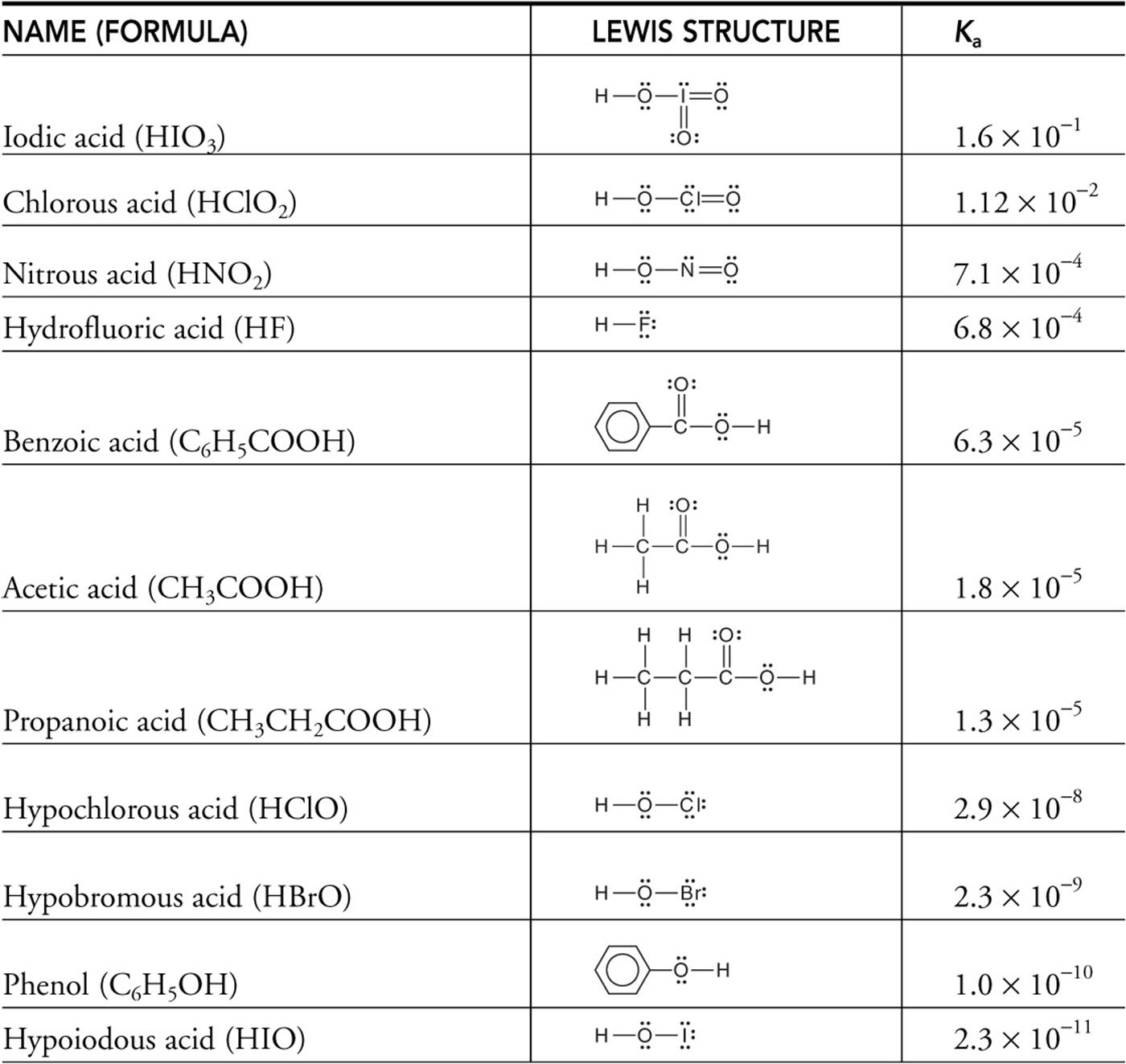
![]()
Here are a couple of tips: For every H+ formed, an A– is formed, so the numerator of the Ka expression can be expressed as [H+]2 (or [A–]2, although it is rarely done this way). Also, the [HA] is the equilibrium molar concentration of the undissociated weak acid, not its initial concentration. The exact expression would then be [HA] = Minitial – [H+], where Minitial is the initial concentration of the weak acid. This is true because for every H+ that is formed, an HA must have dissociated. However, many times if Ka is small, you can approximate the equilibrium concentration of the weak acid by its initial concentration, [HA] = Minitial.
If the initial molarity and Ka of the weak acid are known, the [H+] (or [A–]) can be calculated easily. And if the initial molarity and [H+] are known, Ka can be calculated.
For example, calculate the [H+] of a 0.300 M acetic acid solution.
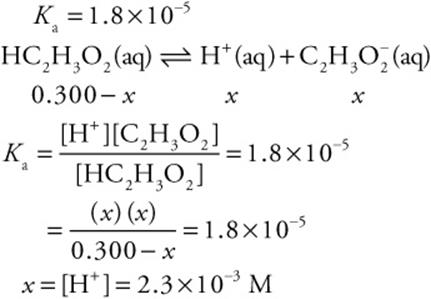
For polyprotic acids, acids that can donate more than one proton, the Ka for the first dissociation is much larger than the Ka for the second dissociation. If there is a third Ka, it is much smaller still. For most practical purposes you can simply use the first Ka.
Kw—the Water Dissociation Constant
Before examining the equilibrium behavior of aqueous solutions of weak bases, let’s look at the behavior of water itself. In the initial discussion of acid–base equilibrium above, we showed water acting both as an acid (proton donor when put with a base) and a base (proton acceptor when put with an acid). Water is amphoteric, it will act as either an acid or a base, depending on whether the other species is a base or acid. But in pure water the same amphoteric nature is noted. In pure water a very small amount of proton transfer is taking place:
![]()
This is commonly written as:
![]()
There is an equilibrium constant, called the water dissociation constant, Kw, which has the form:
![]()
Again, the concentration of water is a constant and is incorporated into Kw.
The numerical value of Kw of 1.0 × 10–14 is true for the product of the [H+] and [OH-] in pure water and for aqueous solutions of acids and bases.
In the discussion of weak acids, we indicated that the [H+] = [A–]. However, there are two sources of H+ in the system: the weak acid and water. The amount of H+ that is due to the water dissociation is very small and can be easily ignored.
pH
Because the concentration of the hydronium ion, H3O+, can vary tremendously in solutions of acids and bases, a scale to easily represent the acidity of a solution was developed. It is called the pH scale and is related to the [H3O+]:
![]()
Remember that in pure water Kw = [H3O+][OH–] = 1.0 × 10–14. Since both the hydronium ion and hydroxide ions are formed in equal amounts, the Kw expression can be expressed as:
![]()
Solving for [H3O+] gives us [H3O+] = 1.0 × 10–7. If you then calculate the pH of pure water:
![]()
The pH of pure water is 7.00. On the pH scale this is called neutral. A solution whose [H3O+] is greater than in pure water will have a pH less than 7.00 and is called acidic. A solution whose [H3O+] is less than in pure water will have a pH greater than 7.00 and is called basic. Figure 15.2, on the next page, shows the pH scale and the pH values of some common substances.
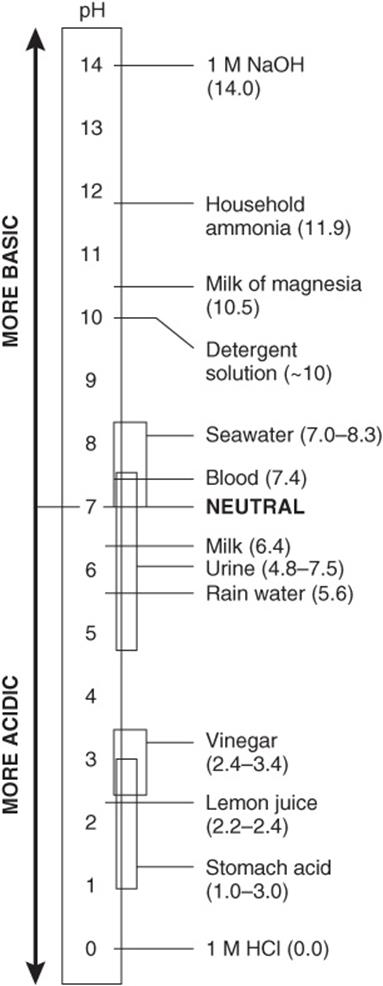
Figure 15.2 The pH scale.
The pOH of a solution can also be calculated. It is defined as pOH = –log[OH–]. The pH and the pOH are related:
![]()
In any of the problems above in which [H+] or [OH–] was calculated, you can now calculate the pH or pOH of the solution.
You can estimate the pH of a solution by looking at its [H+]. For example, if a solution has an [H+] = 1 × 10–5, its pH would be 5. This value was determined from the value of the exponent in the [H+].
Kb—the Base Dissociation Constant
Weak bases (B), when placed into water, also establish an equilibrium system much like weak acids:
![]()
The equilibrium constant expression is called the weak base dissociation constant, Kb, and has the form:

The same reasoning that was used in dealing with weak acids is also true here: [HB+] = [OH–]; [HB] ≈Minitially; the numerator can be represented as [OH–]2; and knowing the initial molarity and Kb of the weak base, the [OH–] can easily be calculated. And if the initial molarity and [OH–] are known, Kb can be calculated.
For example, a 0.500 M solution of ammonia has a pH of 11.48. What is the Kb of ammonia?

The Ka and Kb of conjugate acid–base pairs are related through the Kw expression:
![]()
This equation shows an inverse relationship between Ka and Kb for any conjugate acid–base pair.
This relationship may be used in problems such as: Determine the pH of a solution made by adding 0.400 mol of strontium acetate to sufficient water to produce 2.000 L of solution.
Solution:
The initial molarity is 0.400 mol/2.000 L = 0.200 M.
When a salt is added to water dissolution will occur:
![]()
The resultant solution, since strontium acetate is soluble, has 0.200 M Sr2+ and 0.400 M ![]() .
.
Ions such as Sr2+, which come from strong acids or strong bases, may be ignored in this type of problem. Ions such as ![]() , from weak acids or bases, will undergo hydrolysis. The acetate ion is the conjugate BASE of acetic acid (Ka = 1.8 × 10–5). Since acetate is not a strong base this will be a Kb problem, and OH- will be produced. The equilibrium is:
, from weak acids or bases, will undergo hydrolysis. The acetate ion is the conjugate BASE of acetic acid (Ka = 1.8 × 10–5). Since acetate is not a strong base this will be a Kb problem, and OH- will be produced. The equilibrium is:

Determining Kb from Ka (using Kw = KaKb = 1.0 × 10–14;) gives:
![]()
with x = 1.5 × 10–5= [OH–], and pH = 9.180
Acidic/Basic Properties of Salts
The behavior of a salt will depend upon the acid–base properties of the ions present in the salt. The ions may lead to solutions of the salt being acidic, basic, or neutral. The pH of a solution depends on hydrolysis, a generic term for a variety of reactions with water. Some ions will undergo hydrolysis and this changes the pH.
The reaction of an acid and a base will produce a salt. The salt will contain the cation from the base and the anion from the acid. In principle, the cation of the base is the conjugate acid of the base, and the anion from the acid is the conjugate base of the acid. Thus, the salt contains a conjugate acid and a conjugate base. This is always true in principle. In some cases, one or the other of these ions is not a true conjugate base or a conjugate acid. Just because the ion is not a true conjugate acid or base does not mean that we cannot use the ion as if it were.
The conjugate base of any strong acid is so weak that it will not undergo any significant hydrolysis; the conjugate acid of any strong base is so weak that it, too, will not undergo any significant hydrolysis. Ions that do not undergo any significant hydrolysis will have no effect upon the pH of a solution and will leave the solution neutral. The presence of the following conjugate bases ![]() and
and ![]() will leave the solution neutral. The cations from the strong bases,
will leave the solution neutral. The cations from the strong bases, ![]() and Ba2+, while not true conjugate acids, will also leave the solution neutral. Salts containing a combination of only these cations and anions are neutral.
and Ba2+, while not true conjugate acids, will also leave the solution neutral. Salts containing a combination of only these cations and anions are neutral.
The conjugate base from any weak acid is a strong base and will undergo hydrolysis in aqueous solution to produce a basic solution. If the conjugate base (anion) of a weak acid is in a salt with the conjugate of a strong base (cation), the solution will be basic, because only the anion will undergo any significant hydrolysis. Salts of this type are basic salts. All salts containing the cation of a strong base and the anion of a weak acid are basic salts.
The conjugate acid of a weak base is a strong acid, and it will undergo hydrolysis in an aqueous solution to make the solution acidic. If the conjugate acid (cation) of a weak base is in a salt with the conjugate base of a strong acid (anion), the solution will be acidic, because only the cation will undergo any significant hydrolysis. Salts of this type are acidic salts. All salts containing the cation of a weak base and the anion of a strong acid are acidic salts.
There is a fourth category, consisting of salts that contain the cation of a weak base with the anion of a weak acid. Prediction of the acid–base character of these salts is less obvious, because both ions undergo hydrolysis. The two equilibria not only alter the pH of the solution, but also interfere with each other. Predictions require a comparison of the K values for the two ions. The larger K value predominates. If the larger value is Ka, the solution is acidic. If the larger value is Kb, the solution is basic. In the rare case where the two values are equal, the solution would be neutral.
The following table summarizes this information:

For example, suppose you are asked to determine if a solution of sodium carbonate, Na2CO3, is acidic, basic, or neutral. Sodium carbonate is the salt of a strong base (NaOH) and a weak acid ![]() . Salts of strong bases and weak acids are basic salts. As a basic salt, we know the final answer must be basic (pH above 7).
. Salts of strong bases and weak acids are basic salts. As a basic salt, we know the final answer must be basic (pH above 7).
Buffers
Buffers are solutions that resist a change in pH when an acid or base is added to them. The most common type of buffer is a mixture of a weak acid and its conjugate base. The weak acid will neutralize any base added, and the weak base of the buffer will neutralize any acid added to the solution. The hydronium ion concentration of a buffer can be calculated using an equation derived from the Ka expression:

Taking the negative log of both sides yields the Henderson–Hasselbalch equation, which can be used to calculate the pH of a buffer:

The weak base Kb expression can also be used giving:

These equations allow us to calculate the pH or pOH of the buffer solution knowing K of the weak acid or base and the concentrations of the conjugate weak acid and its conjugate base. Also, if the desired pH is known, along with K, the ratio of base to acid can be calculated. The more concentrated these species are, the more acid or base can be neutralized and the less the change in buffer pH. This is a measure of the buffer capacity, the ability to resist a change in pH.
Let’s calculate the pH of a buffer. What is the pH of a solution containing 2.00 mol of ammonia and 3.00 mol of ammonium chloride in a volume of 1.00 L?

There are two ways to solve this problem.

Assume x is small:
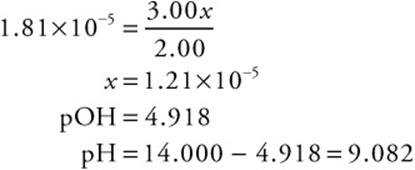
Alternate solution:
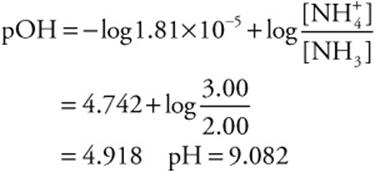
Titration Equilibria
An acid–base titration is a laboratory procedure commonly used to determine the concentration of an unknown solution. A base solution of known concentration is added to an acid solution of unknown concentration (or vice versa) until an acid–base indicator visually signals that the end point of the titration has been reached. The equivalence point is the point at which a stoichiometric amount of the base has been added to the acid. Both chemists and chemistry students hope that the equivalence point and the end point are close together.
If the acid being titrated is a weak acid, then there are equilibria which will be established and accounted for in the calculations. Typically, a plot of pH of the weak acid solution being titrated versus the volume of the strong base added (the titrant) starts at a low pH and gradually rises until close to the equivalence point, where the curve rises dramatically. After the equivalence point region, the curve returns to a gradual increase. This is shown in Figure 15.3.
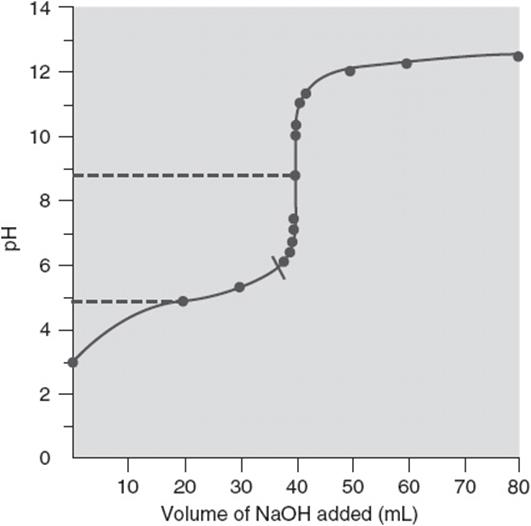
Figure 15.3 The titration of a weak acid with a strong base.
In many cases, one may know the initial concentration of the weak acid, but may be interested in the pH changes during the titration. To study the changes one can divide the titration curve into four distinctive areas in which the pH is calculated.
1. Calculating the initial pH of the weak acid solution is accomplished by treating it as a simple weak acid solution of known concentration and Ka.
2. As base is added, a mixture of weak acid and conjugate base is formed. This is a buffer solution and can be treated as one in the calculations. Determine the moles of acid consumed from the moles of titrant added—that will be the moles of conjugate base formed. Then calculate the molar concentration of weak acid and conjugate base, taking into consideration the volume of titrant added. Finally, apply your buffer equations.
3. At the equivalence point, all the weak acid has been converted to its conjugate base. The conjugate base will react with water, so treat it as a weak base solution and calculate the [OH–] using Kb. Finally, calculate the pH of the solution.
4. After the equivalence point, you have primarily the excess strong base that will determine the pH.
Let’s consider a typical titration problem. A 100.0 mL sample of 0.150 M nitrous acid (pKa = 3.35) was titrated with 0.300 M sodium hydroxide. Determine the pH of the solution after the following quantities of base have been added to the acid solution:
a. 0.00 mL
b. 25.00 mL
c. 49.50 mL
d. 50.00 mL
e. 55.00 mL
f. 75.00 mL
a. 0.00 mL. Since no base has been added, only HNO2 is present. HNO2 is a weak acid, so this can only be a Ka problem.
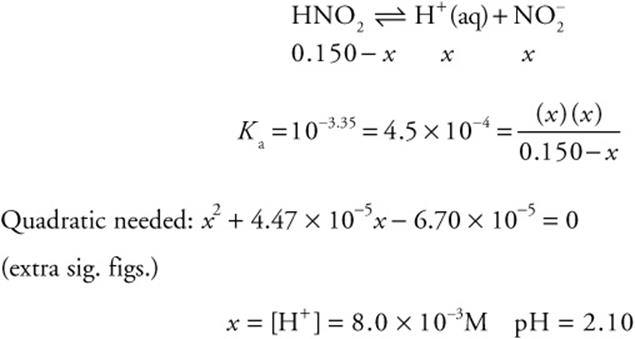
b. 25.00 mL. Since both an acid and a base are present (and they are not conjugates), this must be a stoichiometry problem. Stoichiometry requires a balanced chemical equation and moles.
![]()
![]() could be written as NaNO2, but the separated ions are more useful.
could be written as NaNO2, but the separated ions are more useful.
Acid:![]() mol (This number will be used in all remaining steps.)
mol (This number will be used in all remaining steps.)
Base:
Based on the stoichiometry of the problem, and on the moles of acid and base, NaOH is the limiting reagent.

The stoichiometry part of the problem is finished.
The solution is no longer HNO2 and NaOH, but HNO2 and NO2– (a conjugate acid–base pair).
Since a CA/CB pair is present, this is now a buffer problem, and the Henderson–Hasselbalch equation may be used.
![]()
Note the simplification in the CB/CA concentrations. Both moles are divided by exactly the same volume (since they are in the same solution), so the identical volumes cancel.
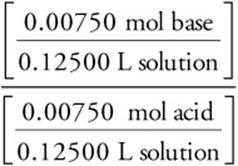
c. 49.50 mL. Since both an acid and a base are present (and they are not conjugates), this must be a stoichiometry problem again. Stoichiometry requires a balanced chemical equation and moles.

Based on the stoichiometry of the problem, and on the moles of acid and base, NaOH is the limiting reagent.

The stoichiometry part of the problem is finished.
The solution is no longer HNO2 and NaOH, but HNO2 and ![]() (a conjugate acid–base pair).
(a conjugate acid–base pair).
Since a CA/CB pair is present, this is now a buffer problem, and the Henderson–Hasselbalch equation may be used.
![]()
d. 50.00 mL. Since both an acid and a base are present (and they are not conjugates), this must be a stoichiometry problem. Stoichiometry requires a balanced chemical equation and moles.

Based on the stoichiometry of the problem, and on the moles of acid and base, both are limiting reagents.

The stoichiometry part of the problem is finished.
The solution is no longer HNO2 and NaOH, but an ![]() solution (a conjugate base of a weak acid).
solution (a conjugate base of a weak acid).
Since the CB of a weak acid is present, this is a Kb problem.
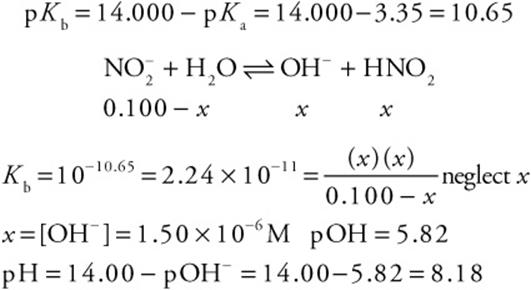
e. 55.00 mL. Since both an acid and a base are present (and they are not conjugates), this must be a stoichiometry problem. Stoichiometry requires a balanced chemical equation and moles.

Based on the stoichiometry of the problem, and on the moles of acid and base, the acid is now the limiting reagent.

The strong base will control the pH.
![]()
The stoichiometry part of the problem is finished.
Since this is now a solution of a strong base, it is now a simple pOH/pH problem.

f. 75.00 mL. Since both an acid and a base are present (and they are not conjugates), this must be a stoichiometry problem. Stoichiometry requires a balanced chemical equation and moles.

Based on the stoichiometry of the problem, and on the moles of acid and base, the acid is now the limiting reagent.

The strong base will control the pH.
![]()
The stoichiometry part of the problem is finished.
Since this is now a solution of a strong base, it is now a simple pOH/pH problem.

Solubility Equilibria
Many salts are soluble in water, but some are only slightly soluble. These salts, when placed in water, quickly reach their solubility limit and the ions establish an equilibrium system with the undissolved solid. For example, PbSO4, when dissolved in water, establishes the following equilibrium:
![]()
The equilibrium constant expression for systems of slightly soluble salts is called the solubility product constant, Ksp. It is the product of the ionic concentrations, each one raised to the power of the coefficient in the balanced chemical equation. It contains no denominator since the concentration of a solid is, by convention, 1 and does not appear in the equilibrium constant expressions. (Some textbooks will say that the concentrations of solids, liquids, and solvents are included in the equilibrium constant.) The Ksp expression for the PbSO4 system would be:
![]()
For this particular salt the numerical value of Ksp is 1.6 × 10–8 at 25°C. Note that the Pb2+ and ![]() ions are formed in equal amounts, so the right-hand side of the equation could be represented as [x]2. If the numerical value of the solubility product constant is known, then the concentration of the ions can be determined. And if one of the ion concentrations can be determined, then Ksp can be calculated.
ions are formed in equal amounts, so the right-hand side of the equation could be represented as [x]2. If the numerical value of the solubility product constant is known, then the concentration of the ions can be determined. And if one of the ion concentrations can be determined, then Ksp can be calculated.
For example, the Ksp of magnesium fluoride in water is 8 × 10–8. How many grams of magnesium fluoride will dissolve in 0.250 L of water?
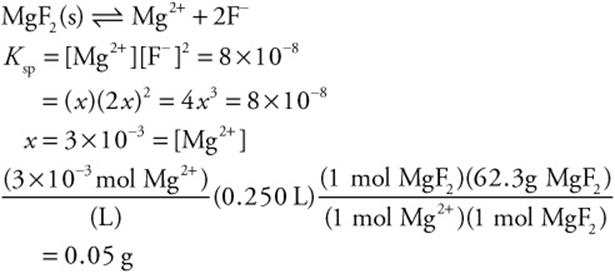
If a slightly soluble salt solution is at equilibrium and a solution containing one of the ions involved in the equilibrium is added, the solubility of the slightly soluble salt is decreased. For example, let’s again consider the PbSO4equilibrium:
![]()
Suppose a solution of Na2SO4 is added to this equilibrium system. The additional sulfate ion will disrupt the equilibrium, by Le Châtelier’s principle, and shift it to the left, decreasing the solubility. The same would be true if you tried to dissolve PbSO4 in a solution of Na2SO4 instead of pure water—the solubility would be lower. This application of Le Châtelier’s principle to equilibrium systems of slightly soluble salts is called the common-ion effect. Calculations like the ones above involving finding concentrations and Ksp can still be done, but the concentration of the additional common ion will have to be inserted into the solubility product constant expression. Sometimes, if Ksp is very small and the common ion concentration is large, the concentration of the common ion can simply be approximated by the concentration of the ion added.
For example, calculate the silver ion concentration in each of the following solutions:
![]()

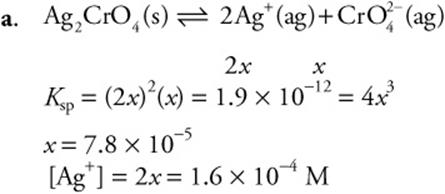
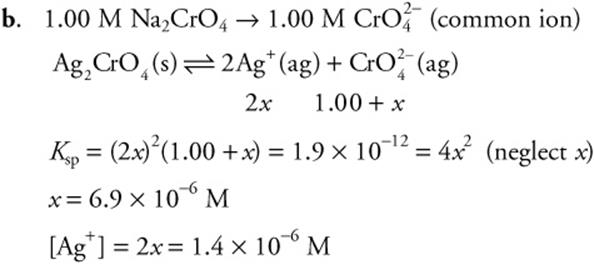
Knowing the value of the solubility product constant can also allow us to predict whether a precipitate will form if two solutions, each containing an ion component of a slightly soluble salt, are mixed. The ion-product, sometimes represented as Q (same form as the solubility product constant), is calculated taking into consideration the mixing of the volumes of the two solutions, and this ion-product is compared to Ksp. If it is greater than Ksp, precipitation will occur until the ion concentrations have been reduced to the solubility level.
If 10.0 mL of a 0.100 M BaCl2 solution is added to 40.0 mL of a 0.0250 M Na2SO4 solution, will BaSO4 precipitate? Ksp for BaSO4 = 1.1 × 10–10
To answer this question, the concentrations of the barium ion and the sulfate ion before precipitation must be used. These may be determined simply from Mdil = Mcon Vcon/Vdil.

Entering these values into the following relation produces:
![]()
Since Q is greater than Ksp, precipitation will occur.
Other Equilibria
Other types of equilibria can be treated in much the same way as the ones discussed above. For example, there is an equilibrium constant associated with the formation of complex ions. This equilibrium constant is called the formation constant, ![]() reacts with ammonia to form the
reacts with ammonia to form the ![]() complex ion according to the following equation:
complex ion according to the following equation:
![]()
The ![]() indicating that the equilibrium lies to the right.
indicating that the equilibrium lies to the right.
Experimental
Equilibrium experiments such as 10, 11, and 19 in Chapter 19 (Experimental), directly or indirectly involve filling a table like the following:

Reactants and Products
Initial amount
Change
Equilibrium amount
The initial amounts—concentrations or pressures—are normally zero for the products, and a measured or calculated value for the reactants. Once equilibrium has been established, the amount of at least one of the substances is determined. Based on the change in this one substance and the stoichiometry, the amounts of the other materials may be calculated.
Measurements may include the pressure, the mass (to be converted to moles), the volume (to be used in calculations), and the pH (to be converted into either the hydrogen ion or hydroxide ion concentration). Some experiments measure the color intensity (with a spectrophotometer), which may be converted to a concentration.
Do not make the mistake of “measuring” a change. Changes are never measured; they are always calculated.
Common Mistakes to Avoid
![]()
1. Be sure to check the units and significant figures of your final answer.
2. When writing equilibrium constant expressions, use products over reactants. Each concentration is raised to the power of the coefficient in the balanced chemical equation.
3. In converting from Kc to Kp be sure to use the ideal gas constant, R, whose units are consistent with the units of the partial pressures of the gases.
4. Remember, in working Le Châtelier problems, pressure effects are important only for gases that are involved in the equilibrium.
5. Be sure, when working weak-base problems, to use Kb and not Ka.
6. In titration problems, make sure you compensate for dilution when mixing two solutions together.
7. A Ka expression must have [H+] in the numerator, and a Kb expression must have [OH–] in the numerator.
![]() Review Questions
Review Questions
Use these questions to review the content of this chapter and practice for the AP Chemistry exam. First are 20 multiple-choice questions similar to what you will encounter in Section I of the AP Chemistry exam. Following those is a multipart free-response question like the ones in Section II of the exam. To make these questions an even more authentic practice for the actual exam, time yourself following the instructions provided.
Multiple-Choice Questions
Answer the following questions in 25 minutes. You may not use a calculator. You may use the periodic table and the equation sheet at the back of this book.
1. A 0.1 molar solution of acetic acid (CH3COOH) has a pH of about:
(A) 1
(B) 3
(C) 7
(D) 10
2. Acid Ka, acid dissociation constant

Using the given information, choose the best answer for preparing a pH = 8 buffer.
(A) K2HPO4 + KH2PO4
(B) H3PO4
(C) K2HPO4 + K3PO4
(D) K3PO4
Use the following information for questions 3–4.
Ionization Constants:
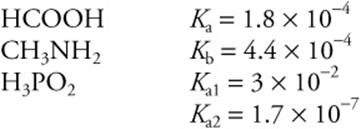
3. What is a solution with an initial KCOOH concentration of 1 M, and an initial K2HPO2concentration of 1 M?
(A) a solution with a pH > 7, which is a buffer
(B) a solution with a pH < 7, which is not a buffer
(C) a solution with a pH < 7, which is a buffer
(D) a solution with a pH > 7, which is not a buffer
4. What is a solution with an initial H3PO2 concentration of 1 M and an initial KH2PO2 concentration of 1 M?
(A) a solution with a pH > 7, which is a buffer
(B) a solution with a pH < 7, which is not a buffer
(C) a solution with a pH < 7, which is a buffer
(D) a solution with a pH > 7, which is not a buffer
5. A solution of a weak base is titrated with a solution of a standard strong acid. The progress of the titration is followed with a pH meter. Which of the following observations would occur?
(A) The pH of the solution gradually decreases throughout the experiment.
(B) Initially the pH of the solution drops slowly, and then it drops much more rapidly.
(C) At the equivalence point, the pH is 7.
(D) After the equivalence point, the pH becomes constant because this is the buffer region.
6. What is the ionization constant, Ka, for a weak monoprotic acid if a 0.30 molar solution has a pH of 4.0?
(A) 3.3 × 10–8
(B) 4.7 × 10–2
(C) 1.7 × 10–6
(D) 3.0 × 10–4
7. Phenol, C6H5OH, has Ka = 1.0 × 10–10. What is the pH of a 0.010 M solution of phenol?
(A) between 3 and 7
(B) 10
(C) 2
(D) between 7 and 10
8. You are given equimolar solutions of each of the following. Which has the lowest pH?
(A) NH4Cl
(B) NaCl
(C) K3PO4
(D) Na2CO3
9. When sodium nitrite dissolves in water:
(A) the solution is acidic because of hydrolysis of the sodium ion
(B) the solution is basic because of hydrolysis of the ![]()
(C) the solution is basic because of hydrolysis of the sodium ion
(D) the solution is acidic because of hydrolysis of the ![]() ion
ion
10. Which of the following solutions has a pH nearest 7?
(A) 1 M H2C2O4 (oxalic acid) and 1 M KHC2O4(potassium hydrogen oxalate)
(B) 1 M KNO3 (potassium nitrate) and 1 M HNO3 (nitric acid)
(C) 1 M NH3 (ammonia) and 1 M NH4NO3(ammonium nitrate)
(D) 1 M CH3NH2 (methylamine) and 1 M HC2H3O2 (acetic acid)
11. Determine the OH–(aq) concentration in 1.0 M aniline (C6H5NH2) solution. (The Kb for aniline is 4.0 × 10–10.)
(A) 2.0 × 10–5M
(B) 4.0 × 10–10M
(C) 3.0 × 10–6M
(D) 5.0 × 10–7M
12. A student wishes to reduce the zinc ion concentration in a saturated zinc iodate solution to 1 × 10–6 M. How many moles of solid KIO3 must be added to 1.00 L of solution? [Ksp Zn(IO3)2 = 4 ×10–6 at 25°C]
(A) 1 mol
(B) 0.5 mol
(C) 2 mol
(D) 4 mol
13. At constant temperature, a change in volume will NOT affect the moles of substances present in which of the following?
![]()
![]()
![]()
![]()
14. The equilibrium constant for the hydrolysis of ![]() is best represented by which of the following?
is best represented by which of the following?
![]()
![]()
![]()
![]()
15.![]() What is the equilibrium constant for the above reaction? The successive acid dissociation constants for H2S are 9.5 × 10–8 (Ka1) and 1 × 10–19(Ka2). The Ksp, the solubility product constant, for ZnS equals 1.6 × 10–24.
What is the equilibrium constant for the above reaction? The successive acid dissociation constants for H2S are 9.5 × 10–8 (Ka1) and 1 × 10–19(Ka2). The Ksp, the solubility product constant, for ZnS equals 1.6 × 10–24.
![]()
![]()
![]()
![]()
16.![]() endothermic An equilibrium mixture of the reactants is placed in a sealed container at 150°C. The amount of the products may be increased by which of the following changes?
endothermic An equilibrium mixture of the reactants is placed in a sealed container at 150°C. The amount of the products may be increased by which of the following changes?
(A) increasing the volume of the container
(B) raising the temperature of the container and increasing the volume of the container
(C) raising the temperature of the container
(D) increasing the volume of the container and adding 1 mol of C(s) to the container
17. ![]()
A 1.00 L flask is filled with 0.30 mol of CH4 and 0.40 mol of CO2, and allowed to come to equilibrium. At equilibrium, there are 0.20 mol of CO in the flask. What is the value of Kc, the equilibrium constant, for the reaction?
(A) 1.2
(B) 0.027
(C) 0.30
(D) 0.060
18. ![]()
The above materials were sealed in a flask and allowed to come to equilibrium at a certain temperature. A small quantity of O2(g) was added to the flask, and the mixture was allowed to return to equilibrium at the same temperature. Which of the following has increased over its original equilibrium value?
(A) the quantity of NO2(g) present
(B) the quantity of NO(g) present
(C) the equilibrium constant, K, increases
(D) the rate of the reaction
19.![]()
In order to increase the value of the equilibrium constant, K, which of the following changes must be made to the above equilibrium?
(A) increase the temperature
(B) increase the volume
(C) decrease the temperature
(D) add CO(g)
20. The addition of nitric acid increases the solubility of which of the following compounds?
(A) KCl(s)
(B) Pb(CN)2(s)
(C) Cu(NO3)2(s)
(D) NH4NO3(s)
Answers and Explanations for the Multiple-Choice Questions
1. B—An acid, any acid, will give a pH below 7; thus, answers C and D are eliminated. A 0.1 molar solution of a strong acid would have a pH of 1. Acetic acid is not a strong acid, and this eliminates answer A.
2. A—The K nearest 10–8 will give a pH near 8. The answer must involve the ![]() ion.
ion.
3. D—The two substances are not a conjugate acid–base pair, so this is not a buffer. Both compounds are salts of a strong base and a weak acid; such salts are basic (pH > 7).
4. C—The two substances constitute a conjugate acid–base pair, so this is a buffer. The pH should be near –log Ka1. This is about 2 (acid).
5. B—Any time an acid is added, the pH will drop. The reaction of the weak base with the acid produces the conjugate acid of the weak base. The combination of the weak base and its conjugate is a buffer, so the pH will not change very much until all the base is consumed. After all the base has reacted, the pH will drop much more rapidly. The equivalence point of a weak base–strong acid titration is always below 7 (only strong base–strong acid titrations will give a pH of 7 at the equivalence point). The value of pOH is equal to pKb halfway to the equivalence point.
6. A—If pH = 4.0, then [H+] = 1 × 10–4 =[A–], and [HA] = 0.30 – 1 × 10–4. The generic Ka is [H+][A–]/[HA], and when the values are entered into this equation: (1 × 10–4)2/0.30 = 3.3 × 10–8. Since you can estimate the answer, no actual calculations are necessary.
7. A—This is an acid-dissociation constant, thus the solution must be acidic (pH < 7). The pH of a 0.010 M strong acid would be 2.0. This is not a strong acid, so the pH must be above 2.
8. A—A is the salt of a strong acid and a weak base; it is acidic. B is a salt of a strong acid and a strong base; they are neutral. C and D are salts of a weak acid and a strong base; they are basic. The lowest pH would be the acidic choice.
9. B—Sodium nitrite is a salt of a weak acid and a strong base. Ions from strong bases, Na+ in this case, do not undergo hydrolysis, and do not affect the pH. Ions from weak acids, NO2– in this case, undergo hydrolysis to produce basic solutions.
10. D—The weak acid and the weak base partially cancel each other to give a nearly neutral solution.
11. A—The equilibrium constant expression is: ![]() This expression becomes: (x)(x)/(1.0 × x) = 4.0 × 10–10, which simplifies to: x2/1.0 = 4.0 ×10–10. Taking the square root of each side gives: x = 2.0 × 10–5 = [OH–]. Since you can estimate the answer, no actual calculations are necessary.
This expression becomes: (x)(x)/(1.0 × x) = 4.0 × 10–10, which simplifies to: x2/1.0 = 4.0 ×10–10. Taking the square root of each side gives: x = 2.0 × 10–5 = [OH–]. Since you can estimate the answer, no actual calculations are necessary.
12. C—The solubility-product constant expression is: ![]() . This may be rearranged to:
. This may be rearranged to: ![]() . Inserting the desired zinc ion concentration gives:
. Inserting the desired zinc ion concentration gives: ![]() . Taking the square root of each side leaves a desired
. Taking the square root of each side leaves a desired ![]() concentration of 2 M. Two moles of KIO3 must be added to 1.00 L of solution to produce this concentration. Since you can estimate the answer, no actual calculations are necessary.
concentration of 2 M. Two moles of KIO3 must be added to 1.00 L of solution to produce this concentration. Since you can estimate the answer, no actual calculations are necessary.
13. A—When dealing with gaseous equilibriums, volume changes are important when there is a difference in the total number of moles of gas on opposite sides of the equilibrium arrow. All the answers, except A, have differing numbers of moles of gas on opposite sides of the equilibrium arrow.
14. C—Hydrolysis of any ion begins with the interaction of that ion with water. Thus, both the ion and water must be on the left side of the equilibrium arrow, and hence in the denominator of the equilibrium-constant expression (water, as all solvents, will be left out of the expression). The oxalate ion is the conjugate base of a weak acid. As a base it will produce OH– in solution along with the conjugate acid ![]() of the base. The equilibrium reaction is:
of the base. The equilibrium reaction is: ![]()
15. C—The equilibrium given is actually the sum of the following three equilibriums:
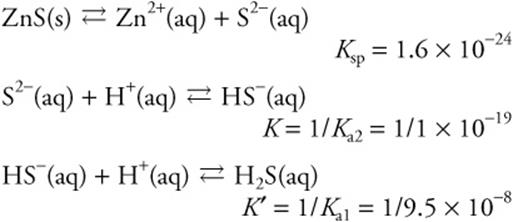
Summing these equations means you need to multiply the equilibrium constants:

16. B—The addition or removal of some solid, as long as remains some present, will not change the equilibrium. An increase in volume will cause the equilibrium to shift toward the side with more moles of gas (right). Raising the temperature of an endothermic process will shift the equilibrium to the right. Any shift to the right will increase the amounts of the products.
17. B—Using the following table:
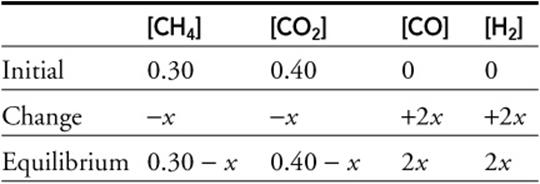
The presence of 0.20 mol of CO (0.20 M) at equilibrium means that 2x = 0.20 and that x = 0.10. Using this value for x, the bottom line of the table becomes:

The equilibrium expression is: K = [CO]2[H2]2/[CH4][CO2]. Entering the equilibrium values into the equilibrium expression gives: K = (0.20)2(0.20)2/(0.20)(0.30)
18. A—The addition of a product will cause the equilibrium to shift to the left. The amounts of all the reactants will increase, and the amounts of all the products will decrease (the O2 will not go below its earlier equilibrium value since excess was added). The value of K is constant, unless the temperature is changed. The rates of the forward and reverse reactions are equal at equilibrium.
19. C—The only way to change the value of K is to change the temperature. For an exothermic process (ΔH < 0), K is increased by a decrease in temperature.
20. B—Nitric acid, being an acid, will react with a base. In addition to obvious bases containing OH–, the salts of weak acids are also bases. All of the anions, except CN–, are from strong acids.
Free-Response Question
You have 15 minutes to answer the following multipart question. You may use a calculator and the tables in the back of the book.
Question 1
An aqueous solution is prepared that is initially 0.100 M in ![]() . After equilibrium is established, the solution is found to be 0.013 M in Cd2+. The products of the equilibrium are Cd2+ (aq) and I–(aq).
. After equilibrium is established, the solution is found to be 0.013 M in Cd2+. The products of the equilibrium are Cd2+ (aq) and I–(aq).
(a) Derive the expression for the dissociation equilibrium constant, Kd, for the equilibrium and determine the value of the constant.
(b) What will be the cadmium ion concentration arising when 0.400 mol of KI is added to 1.00 L of the solution in part a?
(c) A solution is prepared by mixing 0.500 L of the solution from part b and 0.500 L of 2.0 × 10–5 M NaOH. Will cadmium hydroxide, Cd(OH)2, precipitate? The Ksp for cadmium hydroxide is 2.2 × 10–14.
(d) When the initial solution is heated, the cadmium ion concentration increases. Is the equilibrium an exothermic or an endothermic process? Explain how you arrived at your conclusion.
Answer and Explanation for the Free-Response Question
![]()
Give yourself 1 point for this expression.
Using the following table:

The value of [Cd2+] is given (= 0.013), and this is x. This changes the last line of the table to

Entering these values into the Kd expression gives: (0.013)(0.052)4/(0.087) = 1.1 × 10–6.
Give yourself 1 point for this answer. You can also get 1 point if you correctly put your values into the wrong equation.
(b) The table in part a changes to the following:


Give yourself 1 point for the correct setup and 1 point for the correct answer. If you got the wrong value for K in part a, you can still get one or both points for using it correctly.
(c) The equilibrium is ![]()
The dilution reduces both the Cd2+ and OH– concentration by a factor of 2. This gives:
![]()
The reaction quotient is ![]()
This value is less than the Ksp, so no precipitate will form.
Give yourself 1 point for a correct calculation, and another point for the correct conclusion. If you correctly use a wrong [Cd2+] you calculated in part b, you can still get both points.
(d) Since the cadmium ion concentration increases, the equilibrium must shift to the right. Endothermic processes shift to the right when they are heated. This is in accordance with Le Châtelier’s principle.
Give yourself 1 point for endothermic. Give yourself 1 point for mentioning Le Châtelier’s principle.
Your score is based on a total of 8 points. Subtract 1 point if any answer has an incorrect number of significant figures.
![]() Rapid Review
Rapid Review
• A chemical equilibrium is established when two exactly opposite reactions occur in the same container at the same time and with the same rates of reaction.
• At equilibrium the concentrations of the chemical species become constant, but not necessarily equal.
• For the reaction ![]() , the equilibrium constant expression would be:
, the equilibrium constant expression would be: Know how to apply this equation.
Know how to apply this equation.
• Le Châtelier’s principle says that if an equilibrium system is stressed, it will reestablish equilibrium by shifting the reactions involved. A change in concentration of a species will cause the equilibrium to shift to reverse that change. A change in pressure or temperature will cause the equilibrium to shift to reverse that change.
• Strong acids completely dissociate in water, whereas weak acids only partially dissociate.
• Weak acids and bases establish an equilibrium system.
• Under the Brønsted–Lowry acid–base theory, acids are proton (H+) donors and bases are proton acceptors.
• Conjugate acid–base pairs differ only in a single H+; the one that has the extra H+ is the acid.
• The equilibrium for a weak acid is described by Ka, the acid dissociation constant.
It has the form:  Know how to apply this equation.
Know how to apply this equation.
• Most times the equilibrium concentration of the weak acid, [HA], can be approximated by the initial molarity of the weak acid.
• Knowing Ka and the initial concentration of the weak acid allows the calculation of the [H+].
• Water is an amphoteric substance, acting either as an acid or a base.
• The product of the [H+] and [OH–] in a solution or in pure water is a constant, Kw, called the water dissociation constant, 1.0 × 10–14. Kw = [H+] [OH–] = 1.0 × 10–14 at 25°C. Know how to apply this equation.
• The pH is a measure of the acidity of a solution. pH = –log[H+]. Know how to apply this equation and estimate the pH from the [H+].
• On the pH scale 7 is neutral; pH > 7 is basic; and pH < 7 is acidic.
• pH + pOH = pKw = 14.00. Know how to apply this equation.
• Kb is the ionization constant for a weak base.  Know how to apply this equation.
Know how to apply this equation.
• Ka × Kb = Kw for conjugate acid–base pairs. Know how to apply this equation.
• Buffers are solutions that resist a change in pH by neutralizing either an added acid or an added base.
• The Henderson–Hasselbalch equation allows the calculation of the pH of a buffer solution:  Know how to apply this equation.
Know how to apply this equation.
• The buffer capacity is a quantitative measure of the ability of a buffer to resist a change in pH. The more concentrated the acid–base components of the buffer, the higher its buffer capacity.
• A titration is a laboratory technique to determine the concentration of an acid or base solution.
• An acid–base indicator is used in a titration and changes color in the presence of an acid or base.
• The equivalence point or endpoint of a titration is the point at which an equivalent amount of acid or base has been added to the base or acid being neutralized.
• Know how to determine the pH at any point of an acid–base titration.
• The solubility product constant, Ksp, is the equilibrium constant expression for sparingly soluble salts. It is the product of the ionic concentration of the ions, each raised to the power of the coefficient of the balanced chemical equation.
• Know how to apply ion-products and Ksp values to predict precipitation.
• Formation constants describe complex ion equilibria.